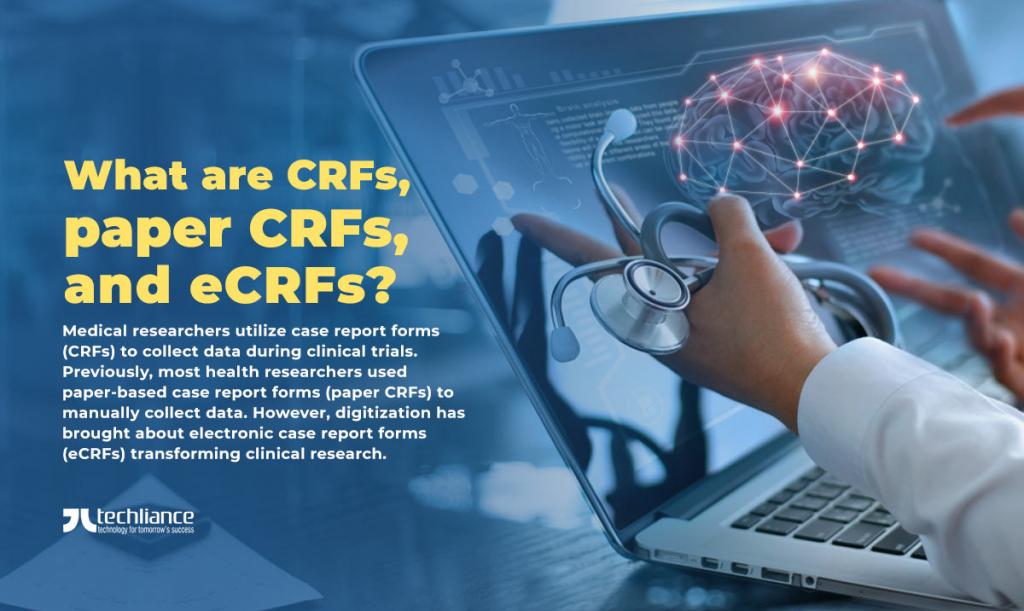Paper CRFs have been the medium of data collection in clinical research globally and the USA. The technology revolution in medical sciences has led them to evolve into eCRF systems. This progress is bringing many rewards to the table in healthcare during 2024.
Experiences of patients as the subjects in clinical trials help in filling data in these forms. While paper CRFs enable researchers to manually collect data. On the other hand, eCRF systems empower them to perform this task electronically.
Are you wondering whether to adopt eCRFs for your clinical studies? Realize that digitizing your case reports will modernize the whole procedure. Proficient dedicated developers can transform your clinical research process.

What are CRFs, paper CRFs, and eCRFs?
Medical researchers utilize case report forms (CRFs) to collect data during clinical trials. Previously, most health researchers used paper-based case report forms (paper CRFs) to manually collect data. However, digitization has brought about electronic case report forms (eCRFs), transforming clinical research.
Thanks to eCRF, the process of clinical data collection now takes place digitally worldwide and in the United States. It closely works with the procedures like electronic data capture (EDC). Whether you use paper CRFs or eCRFs, they are an important part of the clinical data management system (CDMS).
Also, electronic or paper CRFs are necessary for clinical data acquisition. They relate to processes such as data clarification forms (DCFs), patient diaries, and disease registries. In addition, eCRF systems are relevant to the clinical trial management system (CTMS).

Advantages of eCRFs over paper CRFs for clinical research
Put your worries to rest because this article will help bring clarity to your decision-making process. It discusses the benefits of eCRF solutions in comparison to paper CRFs. Read on to get insights as we discuss their advantages under the following aspects.
- Providing flexibility
- Limiting expenditure
- Reducing time
- Sustaining quality
Let’s have a brief look at these factors that necessitate the usage of eCRF systems in 2024.
Providing flexibility
While conducting clinical trials flexibility is the key, especially when it concerns your patients. The result of your clinical study largely depends on them. Subsequently, you must put their needs at the forefront, and one of these needs is flexibility.
Paper CRFs don’t offer many conveniences to your patients. You may ask, how? There’s a lot of travel time between the patient picking up the CRF and submitting it.
The inconvenience increases when you have specific times your research center operates. Suppose it runs from eight in the morning until five in the afternoon. Few of your patients work from 9 to 5 in their jobs.
So, they won’t have time to come to your facility to acquire or submit their case report forms. It may force them to seek time off from their jobs to participate in your clinical trial. Some participant patients might drop out of the clinical research because of this. And if that happens, where does this leave your clinical trial?
The narrative changes with eCRF software since the forms are available digitally, which means no travel time. Consequently, the patients can access the forms whenever they feel like it. They can fill them in at any time, during the night or day, and submit them.
Instead of visiting your premises physically, they can do away with submission by clicking the button. Particularly, people prefer to remain at home, staying away from going in public, after COVID-19. Thus, the eCRF systems offer many conveniences to your patients. So, they won’t see any need to abandon the clinical trial midway.

Limiting expenditure
Most of the population wants to reduce their expenses to the bare minimum in whatever they’re undertaking. The same applies to medical researchers as they conduct clinical trials. Often, they desire to save money in the initial stages, to fund the most vital phases of the clinical research.
Paper CRFs defeat this purpose. Why you may wonder? You have to print several copies of your CRF such that each of your patients gets access to the form. This number can run into the hundreds, depending on the number of patients and pages on your form.
You’ll incur expenses in getting printing material and accessories. A few prints won’t cost much, but hundreds of copies will certainly offset the prices. Also, decreasing paper consumption means preserving more trees, and thus, greener earth.
Your workers have to go through paper CRFs to identify errors. It is a lengthy process, and it’ll eat into your clinical trial timeframe. Accordingly, you’ll have no choice but to increase the number of workers to quicken the process.
Many workers mean you’ll spend more on wages, benefits, and insurance covers. On the contrary, costs with the use of eCRFs are manageable. Since your patients will fill in their forms digitally, you won’t need many workers to go through the CRFs.
It’s easier to handle large amounts of data digitally than manually. With fewer workers, you won’t incur high operative expenses, decreasing your costs significantly. For example, wages, provident funds, insurance, and other employee benefits.
The digital handling of the data collection process means you won’t need to invest in printing material. Your operational costs will lessen substantially. By investing in eCRFs, you’re cutting expenses, but not sacrificing quality.
Learn more about case report forms:
https://blog.formedix.com/everything-you-need-to-know-about-crfs
Reducing time
When it comes to clinical trials, time is a critical factor. You want to solve various health issues as quickly as possible to promote better medical care. The use of paper CRFs tends to increase the span of clinical research.
Bear in mind patients may commit errors during the manual filling-in process. It’s up to your data analysts to identify these mistakes one by one and from paper to paper. This process known as data cleansing is lengthy, increasing the time spent on your clinical trial.
There are situations where your patients don’t provide the information you need for clinical research. They might have given you the wrong type of answers. Or they may have left the necessary fields blank.
If that’s the case, you’ll have no option but to repeat the data collection process. Otherwise, you have to forego your clinical research. As a result, it wastes a lot of time, due to no fruitful outcome.
Conversely, eCRF systems more or less save a considerable amount of time. Incorporate data validation checks to help manage errors by your patients. You must define the type of answers you want on the case report forms.
In the event, that a patient deviates from this, the edit check will highlight the error and inform the patient. The patient will proceed to make the changes and submit the form. Then, you’ll receive forms with minimal errors.
Should there be blanks, the system can refuse to accept the form submission. The patient will go back and fill in the blanks. Once, all the validation checks are met, then the patient can submit the form.
Sustaining quality
When performing clinical trials, maintaining quality is crucial during the data collection process. You want to gather accurate data through your CRFs, whether they are paper-based or electronic. So that you can rely on them to make valid conclusions from your clinical research.
You’re likely to collect inaccurate data when you use paper CRFs. The patients may erroneously fill out the case report forms. Even, if they fill in the forms correctly, the issue may arise with your data analysis team.
This team has to go through each paper CRF and manually transfer the data into your electronic systems. Manual data entry can lead to missing entries, double entries, and wrong entries. These errors reduce the quality of your data, which negatively affects your clinical trial.
Suppose you have to compile the manual records of hundreds of patients. Your data analysis team will get overwhelmed with the many paper CRFs they have to go through. There’s a likelihood of the data analysts getting complacent in having the work done as fast as possible. Remember, fatigue is one major cause of errors in daily tasks.
However, eCRFs greatly change the narrative. The chances of collecting high-quality data you can rely on are high with eCRF systems. You may ask, why? Because patients will fill in data digitally.
Therefore, your workers won’t need to enter data manually. They’ll only copy and paste, or transfer the data to where they need it for analysis. As a result, this significantly diminishes errors.
Such kind of activity isn’t much energy-consuming. It means that your data analysts will execute their duties without fatigue. They’re less likely to get complacent, ensuring quality.

Conclusion
The discussion above highlights the plus points of eCRFs over paper CRFs. With this debate, you can see how innovations bring about efficiency in how you handle your operations in clinical trials. Your team will spend less time and money doing the data cleansing procedure.
This leads to saving much time and costs for your clinical research. As you won’t have to repeat the data collection due to a lack of data, or wrong information. Furthermore, your clinical trial will not face a disaster owing to low quality.
This information places you in a better position to decide whether to adopt eCRFs or stick with paper CRFs. Hopefully, our writeup makes the eCRF vs paper CRFs comparison easy for you. Whichever decision you make, ensure it’s the right one.
Do you want to digitalize clinical research with a bespoke eCRF solution? Techliance can join hands for transforming data collection of your clinical trial process. Together we can ideate and bring this system into reality.




